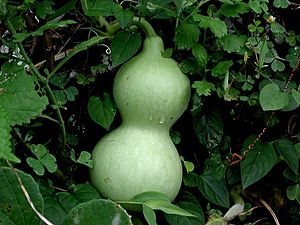Chitarero facts for kids

A calabash gourd or chitarero in the indigenous language, for which the Spanish named the Chitareros
|
|
| Regions with significant populations | |
|---|---|
| Norte de Santander, Santander, Táchira, |
|
| Languages | |
| Chibcha, Colombian Spanish, Venezuelan Spanish | |
| Religion | |
| Traditional religion, Catholicism | |
| Related ethnic groups | |
| Lache, U'wa, Muisca, Guane |
The Chitarero were an ancient group of people who spoke a language called Chibcha. They lived in the Andes mountains, in what is now north-eastern Colombia and north-western Venezuela. They are known for an event in 1533 when the German explorer Ambrosius Ehinger died during a conflict with them, possibly from poisoned arrows.
Contents
Who Were the Chitarero People?
The Chitarero were one of many indigenous groups living in the Andes region of South America. They had their own unique culture and way of life. Their language, Chibcha, was part of a larger family of languages spoken by several groups in the area, including the Muisca.
Where Did the Chitarero Live?
At the time of the Spanish arrival, the Chitarero lived in a large area. This territory stretched from what is now Táchira in Venezuela. It also covered parts of north-west and south of the Norte de Santander Department and the north-east of the Santander Department in Colombia.
Natural features often marked their boundaries. The Chicamocha River was their southern border. The Valegra River formed their south-western edge, and the Surata River was their south-eastern boundary. One of their settlements later became the Colombian town of Chinácota. They were especially well-known in the area around Pamplona, Colombia. When Pamplona was re-established in 1549, it was estimated that about 200,000 Chitarero people lived in the region.
How Did the Chitarero Get Their Name?
The Spanish explorers gave the Chitarero people their name. This happened because of a common custom among the men. They would carry a special gourd, like a small bottle, hanging from their waist. This gourd was called a calabazo or totumo, which is a type of calabash. Inside, they kept maize wine, which the Spanish called chicha.
When the Spanish asked what this item was called, the native people replied that it was a chitarero. So, the Spanish started calling the entire group "Chitareros" after this gourd.
What Was Daily Life Like for the Chitarero?
The Chitarero people were skilled traders. They exchanged goods with other groups in their region. These trading partners included the Muisca, the Guane, and the Lache. This trade helped them get resources they needed and share their own products.
Their daily life likely involved farming, crafting, and community activities. Like many indigenous groups, they had their own traditional beliefs and practices.
See also
 In Spanish: Chitareros para niños
In Spanish: Chitareros para niños

